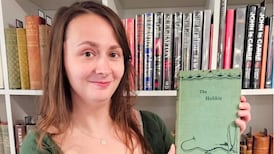Yeats scholars visited a place immortalised in poetry, amid concern it may soon fall into private ownership, writes Rosita Boland
Every year at the Yeats Summer School, one of the highlights of the fortnight is the bus-trip out to Lissadell House. The bus stops briefly at Strand Hill en route, but this acts purely as a taster: the real purpose of the excursion is the great gaunt house overlooking Sligo Bay, which is currently the subject of so much national and political debate.
All of Ireland now knows Lissadell House is for sale, offered by Sir Josslyn Gore-Booth, whose family has lived in the area for 400 years: the first Gore-Booth was an Elizabethan settler.
While the public only discovered the estate was on the market when it appeared in the property section of newspapers, the Government actually knew several months ago.
"Sir Josslyn told us he had informed the Government at Easter he was putting it on the market," confirms Ms Ita Leyden, spokeswoman for the action group, Saving Lissadell for the Nation.
The questions now being asked with increasing urgency, both locally and nationally, are: who will buy Lissadell and what will happen to it then?
Although Yeats visited the house only twice, the few oft-quoted lines he wrote about its great windows and beautiful sisters, Constance and Eva, have had the result of for ever imprinting Lissadell upon an international literary conscience.
A local Fianna Fáil TD, Mr Jimmy Devins, reports that Sligo County Council is currently putting together a business plan for Lissadell, which it will present to the Government within the next few weeks.
Although nobody in Sligo this week appeared to believe in any other end-result than that of the State buying the house, there is also a nervousness in the way people speak of the sale.
It is well known that the present Gore-Booth family are keen to sell, and there is a growing fear that the longer it drags on the more likely it is that the house may disappear into the chasm of private ownership. It is, after all, for sale on the open market at a relatively modest sum. Bono of U2 has already been to view it three times, the last time flying in by helicopter at the weekend.
It is tacitly accepted that the Gore-Booth family would make themselves hugely unpopular if they did accept a private offer, but technically it is entirely possible.
For the Yeats scholars on the bus-trip to Lissadell yesterday, the fact that the house is for sale was an additional prompt for them to come and see it this year. "Who knows what will happen to it?" Mr Tom Kersting, from upstate New York, says rhetorically, as the bus pulls out of Sligo.
Lissadell is still open to the public as usual, with tours from June to mid-September, every day except Sunday. Even in August the house feels cool. In the entrance hall, which is the same way the family come in, there is a row of dirty wellies and Barbour jackets hanging up, a pair of socks draped over one green boot.
The group, many of whom are American, are openly aghast as we move through the house. They tut-tut and whisper to each other in between the talk given by the guide, Englishwoman Ms Susan Gadsby.
"Look, the plaster is coming off the wall." "Look, the drapes are in tatters." "Look, the ceiling is falling down."
The group peer up at the forest of stag heads on the wall of the billiard room, with its dark-red William Morris wallpaper. In the huge high gallery they look lost and start whispering again, until Ms Sarah Bennett volunteers to play a few chords on the grand piano, one of the few items of furniture in the echo-y room. There are a couple of bookcases here: one of the titles is appositely-titled Vanishing Country Houses of Ireland. Everyone shuffles up to the red cord that marks off the famous drawing room and peers in.
There are cracks on the walls and lots of grey wires hanging down from a point over the fireplace, connected to nothing. Here, as elsewhere, the paintwork on walls and doors is in poor condition. The names of her siblings that Constance scratched with a diamond on the glass of the ante-room window endure, although one pane is now cracked.
The group look at it with respect. Nobody asks any questions; they meekly tiptoe from one big bare room to the next.
In the dining room, a laugh is raised when Ms Gadsby reads from a hand-made menu, with a painted daffodil, dated March 13th, 1923: "Dinner - white soup, mince and egg."
When the tour is over, she stands in the entrance hall with a mug of tea, as the group mingle. The mug Ms Gadsby is holding happens to be a commemorative item for the Silver Jubilee of Queen Elizabeth.
The image of the current English queen smiles out upon the estate where Sir Paul Gore settled all of 400 years ago, and which the current Gore-Booths are now about to sell.










